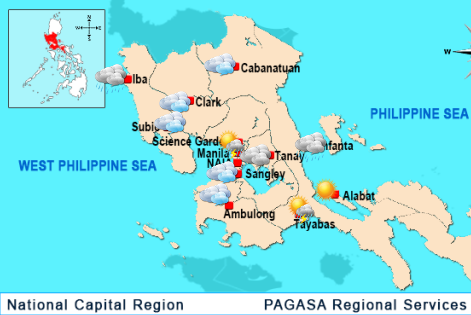
MANILA – Authorities are reminding the people to further exercise caution against extreme heat, expecting the Philippines to experience this April twin onslaught of the dry season’s peak and the prevailing drought-driving El Nino phenomenon’s brunt.
“We must prepare for such simultaneous occurrence,” said senior weather specialist Analiza Solis from the state-run Philippine Atmospheric, Geophysical and Astronomical Services Administration (PAGASA).
She warned of higher temperature and further rainfall shortage this month, noting El Nino is exacerbating the hotter- and drier-than-usual weather conditions that generally prevail during the dry season’s peak.
According to Department of Health (DOH), exposure to hightemperature can cause heat cramps, heat exhaustion, heat injury, heat stroke and other illnesses.
DOH also warned that water scarcity can lead to diarrhea, skin diseases and red tide-induced paralytic shellfish poisoning.
Data from PAGASA this week show the Philippines’ maximumtemperature in April 2016 can soar to nearly 40°C in lowlands and northern areas of Luzon.
Such forecast is higher than the 26.6°C mean annual temperature PAGASA reported for the country.
All regions nationwide except Region II (Cagayan Valley) face this April up to an entire month of dry days each having rainfall 1.0 millimeter or less, PAGASA further said.
PAGASA also forecast way below-normal rainfall this April in the National Capital Region, Cordillera Administrative Region, Negros Island Region as well as Regions I, II, III, IV-A, IV-B, V, VI, VII, VIII, IX and X.
Some 38 percent of the country or about 30 provinces – mostly in Mindanao – will likely experience drought by April 2016’s end, PAGASA said.
According to PAGASA, drought is a condition marked by three consecutive months of way below-normal rainfall.
Drought can also be five consecutive months of below-normal rainfall condition, PAGASA noted.
“El Niño is still prevailing even if this phenomenon is already heading towards its decaying stage,” said Anthony Lucero, OIC of PAGASA’s Climate Monitoring and Prediction Section, explaining the agency’s way below-normal rainfall forecast for most areas of the country this April.
He said PAGASA expects El Nino to gradually weaken through the March-April May 2016 period, then transition to neutral during the May-June-July period this year.
Experts said El Nino and the La Nina phenomenon are the warm and cool phases, respectively, of a recurring natural climate pattern called El Nino-Southern Oscillation (ENSO) across the tropical Pacific.
They noted an ENSO-neutral state is one in which conditions are near long-term average.
Lucero said rain-driving weather systems that can affect the Philippines from May to August 2016 are tropical cyclones (TCs), southwest monsoon, local thunderstorms, inter-tropical convergence zone and low-pressure area.
He said PAGASA forecasts one to three TCs in the country this July.
The country may experience two to four TCs in August 2016, he also said.
To help cope with hot and dry weather, DOH earlier recommended drinking more fluids and avoiding strenuous physical activity.
“Wear light clothing,” DOH also advised people.
It added using water wisely and protecting it from contamination will help ensure availability of this resource.